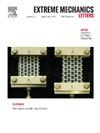Energy dissipation mechanism of G-phase and L-phase metallic glass nanofilms subjected to high-velocity nano-ballistic impact
IF 4.3
3区 工程技术
Q2 MATERIALS SCIENCE, MULTIDISCIPLINARY
引用次数: 0
Abstract
The energy dissipation mechanisms of G-phase and L-phase metallic glass nanofilms subjected to high-velocity nano-particle impact were investigated by molecular dynamics (MD) simulations. We identified the phase transition from G-phase to L-phase in which the locally ordered core structures transform to liquid-like structures due to local mechanical melting and adiabatic heating of the G-phase under high strain rate impact. The appearance of phase transition provides a new channel for energy dissipation, thus the relatively thicker G-phase nanofilm with ordered core structures has a higher specific energy absorption compared with the L-phase film at the same thickness and impact velocity. However, if the thickness decreases below the characteristic length scale of the heterogeneous structure, the broken core structures in the G-phase films act as prefabricated defects that fail prematurely when subjected to impact, resulting in less impact resistance of the G-phase film compared to the L-phase film. This paper provides a useful method for improving the impact resistance of metallic glass films by tailoring the microstructures.
求助全文
约1分钟内获得全文
求助全文
来源期刊

Extreme Mechanics Letters
Engineering-Mechanics of Materials
CiteScore
9.20
自引率
4.30%
发文量
179
审稿时长
45 days
期刊介绍:
Extreme Mechanics Letters (EML) enables rapid communication of research that highlights the role of mechanics in multi-disciplinary areas across materials science, physics, chemistry, biology, medicine and engineering. Emphasis is on the impact, depth and originality of new concepts, methods and observations at the forefront of applied sciences.
 求助内容:
求助内容: 应助结果提醒方式:
应助结果提醒方式:


